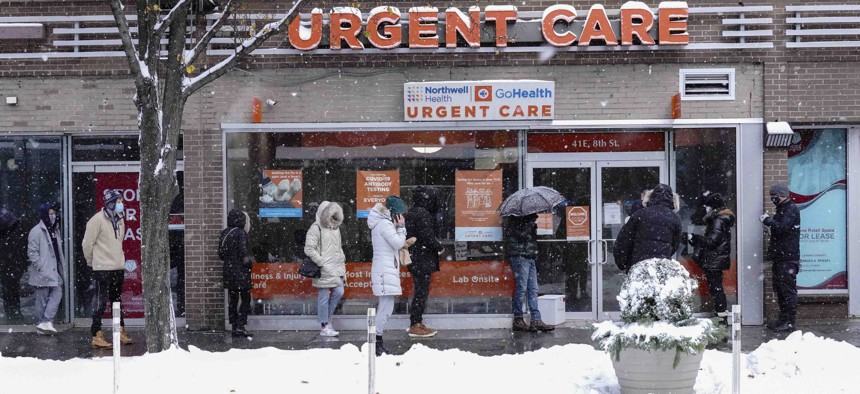Heading Into 2021, State and Local Budget Gloom Lingers

People line up outside a medical clinic for Covid-19 testing on Dec. 17, 2020 in New York City. John Nacion/STAR MAX/IPx 2020
Revenues are better than initially expected in some states. But they’re still down in many places as the cost of the pandemic response adds up.
While state tax collections have in some cases exceeded the bleak projections revenue forecasters issued around the time the coronavirus hit the U.S. in the spring, states’ finances remain steeped in uncertainty and in many ways downbeat as the year ends. Cities and counties, meanwhile, are facing budget challenges of their own.
Virus relief legislation President Trump signed on Sunday promises to help state and local finances. It does not include a giant new slug of direct aid state and local advocates pushed for. But it will inject billions of dollars into the economy to help businesses and households, including $284 billion for a forgivable loan program to help small businesses cover payroll, a $300 increase to weekly unemployment benefits and $600 one-time payments to many Americans.
As with the last major relief package—the CARES Act, passed in March—those federal dollars should boost the economy and state and local revenues along with it.
The new $900 billion relief legislation will also pour additional aid into areas linked to state and local government. For example, K-12 schools will receive $54 billion, higher education gets $22 billion, around $14 billion will be sent to struggling transit systems, and billions will be spent on various vaccine-related initiatives.
But despite this help, state and local budgets will likely be in flux at least until the new Covid-19 vaccines are more widely administered and economic activity ramps back up toward normal.
‘Most States Need Help’
“Overall the fiscal situation remains bad, maybe not as bad as expected, but it’s still bad,” said Lucy Dadayan, a senior researcher with the Urban-Brookings Tax Policy Center.
Dadayan tracks revenue data for 47 states. A report the Urban Institute issued this month shows that when comparing March through October of 2020 to the same block of time last year, 35 states reported total tax revenue declines and 12 showed growth. Also, total state tax revenues were down 4.1% during that March to October timeframe.
Tax revenue declines come on top of any failed revenue growth states banked on, Dadayan noted. So, for example, if a state was heading into a fiscal year expecting revenues to grow by 4% to 5%, their revised budget plans must factor in both those unrealized gains and the losses.
It’s true that tax collections are stronger than forecasted shortly after the pandemic struck, Dadayan said. But she added: “that doesn’t mean that revenues are strong.”
There are other metrics that highlight the tough spot many states and localities find themselves in. One is job losses.
Labor Department figures for November show that state and local government employment was down by about 1.3 million jobs compared to February, before the virus hit. About 1 million of those jobs were local and many in education. A caveat is that interpreting how these job losses look on the ground can be difficult, as they can include layoffs, furloughs, or unfilled positions.
The National Association of State Budget Officers' latest Fiscal Survey of States, released last week, sheds a little more light on what’s happening with state employment. It shows 19 states instituted or continued hiring freezes for fiscal 2021, seven imposed furloughs and two states turned to layoffs. Three states reduced salaries.
Bigger picture, the NASBO survey shows 35 states reported general fund collections for fiscal 2020, which ended June 30 in most states, came in below projections, despite three quarters of relatively strong revenue growth before the Covid-19 crisis. Nineteen states reported mid-year budget cuts for the fiscal year due to revenue shortfalls.
The survey also found that enacted state spending plans for fiscal 2021 cut $6.2 billion in general fund appropriations compared to fiscal 2020—a decline of about 1.1%. Total state general fund spending is now on track to be around $893 billion, about 5.5% short of the $944 billion governors proposed before their states were blindsided by the virus.
“The pandemic is hitting all states, but in differing ways and in differing magnitudes, depending on their economies, tax structures, virus transmission levels, and other factors,” said Shelby Kerns, NASBO’s executive director. “What can get lost in the aggregate numbers is how truly devastating the situation is in some states. Challenging budget choices lie ahead.”
Dadayan said states that have no individual income taxes, but a higher reliance on sales taxes, including Florida and Texas, are enduring some of the steeper declines in revenue. States like Hawaii and Nevada, where tourism and service industries are big parts of the economy, are also in line to take hard hits. Oil-producing states are hurting, too, as that industry struggles.
“Each state has its own story,” Dadayan added. “But it’s clear that most states need help.”
Eric Kim, head of U.S. state ratings for Fitch Ratings, said during an online event this month that an additional round of direct federal aid could be especially beneficial for a handful of states, specifically naming Illinois, Kentucky, Nevada, New York and New Jersey.
“These are states that are facing some challenging budget choices,” he said.
States had record-high “rainy day” fund balances when they began the year. Since then, they’ve begun dipping into these funds. In fiscal 2020, 15 states made withdrawals and another 10 have done so already in fiscal 2021, according to the NASBO report. States reported that rainy day fund balances are down about $12.2 billion compared to 2019.
The Urban Institute report shows that, in October, compared to a year earlier, personal income tax collections did increase by 1.6% among the 47 states it tracks. But this was largely driven by California, where personal income tax collections were up 15.4%, or about $1 billion.
Without California in the mix, the rest of the states saw income tax revenues shrink by 2.3%.
The income tax figure in California, a state with many wealthy residents, reflects the “K-shaped” economic recovery economists say is taking place. Many higher earners and remote-working office professionals, along with the stock market, are doing well. But lower-wage Americans and those in parts of the service economy that depend on in-person customers are struggling.
Federal programs lawmakers approved earlier this year as part of the CARES Act, like expanded unemployment, the Paycheck Protection Program for businesses and $1,200 payments for many individuals, propped up spending and other economic activity. This, in turn, helped to dampen the blow the Covid downturn otherwise might’ve delivered to state and local tax collections.
Even though it’s smaller than the roughly $2.2 trillion CARES Act, Fitch Ratings said last week that the new federal relief package will help stabilize state and local budgets, despite the measure’s lack of direct federal payments for most governments.
But the ratings agency also cautioned that “the new bill's ability to stem recent economic declines and related effects on tax revenues is not assured and depends upon increased business and consumer confidence, which is influenced by vaccination rates.”
Fitch also said that, “With at least a modest economic boost from the new stimulus and widespread vaccination on the horizon, we think direct governmental aid is less critical to financial stability than it was in the early days of the crisis.”
‘More Difficult to Hold the Line’
At the local level, it could be well into 2021 or later before the damage the virus has caused to budgets becomes clear. There are also questions about the lasting marks for some local economies—for instance, if downtown offices will lose tenants if remote work continues or if businesses like restaurants and venues, hobbled by the pandemic, will be able to rebound.
“We don’t even know how bad things are at the local level,” said Matt Fabian, a partner at Municipal Market Analytics. He noted that local government audits to put this year’s financial strain into perspective generally have not been released yet.
But there are signs that localities are under financial pressure. Fabian said he expects heavy activity into 2021 with local deficit financing and transactions known as “scoop and toss”—an often frowned upon refinancing practice. Near-term deficit borrowing could mean some localities end up extending their fiscal pain out two or three years.
After the Great Recession, which unfolded around 2008, municipal defaults were elevated until around 2012, Fabian said. “There’s no reason that’s not going to be the case now,” he said.
On top of falling revenues, states, cities and counties have funded programs established in response to the virus—like testing and contact tracing, as well as economic programs meant to assist renters facing eviction, the homeless, and small businesses.
States and localities also upgraded facilities to cut down on the risk of the virus spreading and bought technology so many public employees could work remotely.
The CARES Act’s Coronavirus Relief Fund provided $139 billion to states, cities and counties that they have spent on these sorts of costs.
But governments have been using the money up. A concern is that funding state and local Covid initiatives as the pandemic drags into next year, and as budgets are otherwise tight, could mean cuts in other areas if additional federal aid to states and localities doesn’t flow.
A provision in the new relief bill should help on this front. It extends the deadline for using the CARES Act relief fund dollars through next year. An original deadline called for the money to be used by Dec. 30. Officials warned that this might force them to rush spending, or to burn through money that could’ve been stretched into 2021.
Fitzroy Lee, chief economist and deputy chief financial officer for Washington, D.C., said during a recent Volcker Alliance event that D.C. spent almost $1.5 billion in budget reserves balancing its fiscal 2020 and 2021 budgets, and has also spent or allocated all of its CARES Act allotment.
“As we go further into fiscal year 2021, if there’s no further pandemic relief,” he said, “it’s going to become much more difficult to hold the line.”
A September budget forecast for the District revised a fiscal 2020 revenue estimate up by $222 million, crediting earlier federal relief for the improvement. But it also said revenue in 2020 would still be down by about $334 million, or 4%, compared to the prior year, and predicted it would fall nearly $155 million further in fiscal 2021.
Julie Demuth, budget manager for Pierce County, Washington, where Tacoma is located, said during the Volcker event that the county had set aside general fund reserves to pay for local Covid response programs for a few months if federal aid runs short. She also explained that a severe plunge in revenues the county braced for earlier on in the pandemic didn’t happen.
“Our sales tax has actually come in above budget,” she said. “We’re largely in a good position revenue-wise.”
The county received $158 million from the CARES Act relief fund. It has used the money for initiatives like Covid testing, case investigations, and assisting schools, restaurants and food banks. Through Dec. 11, the county reported spending $104 million of the aid.
“It goes without saying that additional funding is critical for all states and counties as we move into 2021,” Demuth said, noting that in addition to maintaining public health response programs that are already up and running, Pierce County is also preparing for the vaccine roll out. “The next six to nine months are still not going to be normal for us,” she added.
Bill Lucia is a senior reporter for Route Fifty and is based in Olympia, Washington.
NEXT STORY: She Noticed $200 Million Missing, Then She Was Fired






